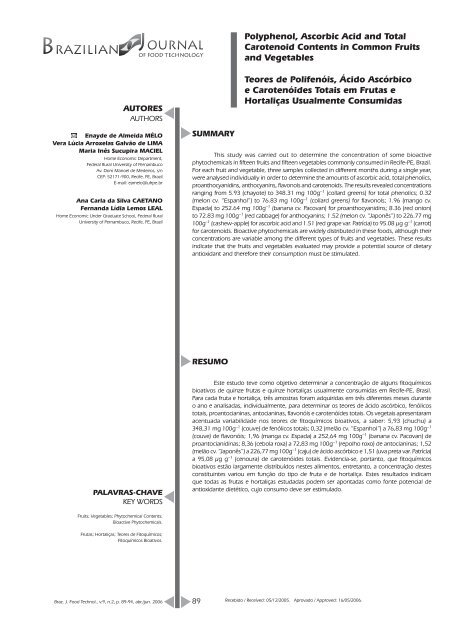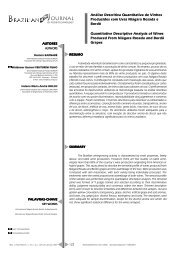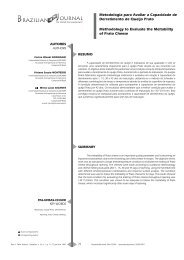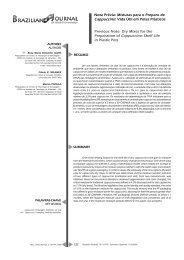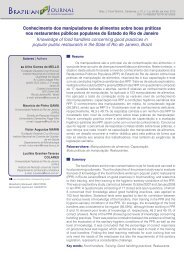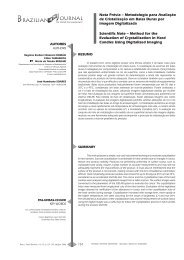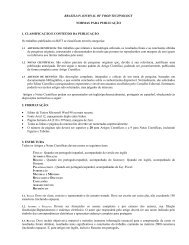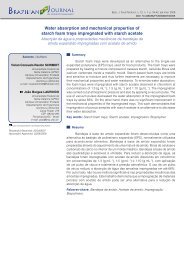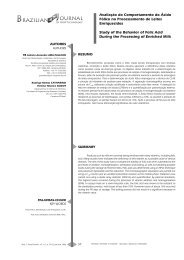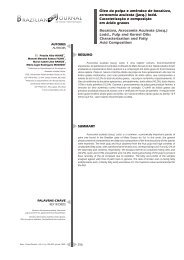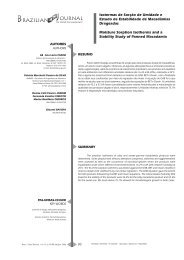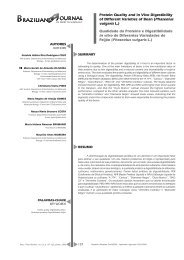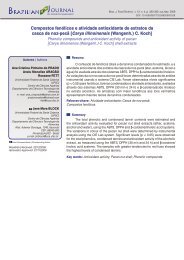Polyphenol, Ascorbic Acid and Total Carotenoid Contents in ...
Polyphenol, Ascorbic Acid and Total Carotenoid Contents in ...
Polyphenol, Ascorbic Acid and Total Carotenoid Contents in ...
You also want an ePaper? Increase the reach of your titles
YUMPU automatically turns print PDFs into web optimized ePapers that Google loves.
MÉLO, E. A. et al.<strong>Polyphenol</strong>, <strong>Ascorbic</strong> <strong>Acid</strong> <strong>and</strong> <strong>Total</strong><strong>Carotenoid</strong> <strong>Contents</strong> <strong>in</strong> Common Fruits<strong>and</strong> Vegetables1. INTRODUCTIONFruits <strong>and</strong> vegetables not only provide a small part ofthe daily caloric <strong>in</strong>take of our diet, but also certa<strong>in</strong> substanceswith antioxidant capacity such as vitam<strong>in</strong> C (ascorbic acid),carotenoids <strong>and</strong> polyphenols. Recently there has been<strong>in</strong>creas<strong>in</strong>g <strong>in</strong>terest <strong>in</strong> the protective biochemical function ofthese phytochemicals <strong>in</strong> the prevention of oxidative damageto an organism. In the past few years, an <strong>in</strong>creas<strong>in</strong>g numberof epidemiological studies have shown an <strong>in</strong>verse correlationbetween the consumption of fruit <strong>and</strong> vegetables <strong>and</strong> the<strong>in</strong>cidence of degenerative diseases (AMES et al., 1993; RICE-EVANS & MILLER, 1995). In the past few years there has been<strong>in</strong>creas<strong>in</strong>g <strong>in</strong>terest <strong>in</strong> determ<strong>in</strong><strong>in</strong>g relevant dietary sources ofantioxidant compounds (ŠKERGET et al., 2005; SCALZO et al.,2005; CIEŚLIK et al., 2006).Interest <strong>in</strong> food composition has broadened to <strong>in</strong>cludebioactive components as well as nutrients. Therefore, the termfunctional food was co<strong>in</strong>ed to describe foods that, as normaldietary constituents, can provide sufficient amounts of bioactivecomponents to prevent or delay chronic disease <strong>and</strong> therebyimprove public health (MILNER, 2002). Data on the levels ofbioactive components <strong>in</strong> foods are needed so that researchmay accurately assess their dietary <strong>in</strong>take, <strong>in</strong>vestigate theirphysiological functions, <strong>and</strong> determ<strong>in</strong>e their relationships tohealth <strong>and</strong> disease (PENNIGTON, 2002).Different plants have different contents of phytochemicalswith different structures <strong>and</strong> thus offer different protectivemechanisms at different levels. Moreover, the phytochemicalcontents of freshly harvested edible plants vary, <strong>and</strong> thesevariations result from an <strong>in</strong>terplay of a number of factors, chieflygenetics, sunlight, reliable ra<strong>in</strong>fall, topography, soils, location,season, soil fertilisation <strong>and</strong> maturity (HARRIS, 1977). Studiesrelat<strong>in</strong>g to the bioactive phytochemical contents of Brazilianfruits <strong>and</strong> vegetables have only been sparsely reported <strong>and</strong>therefore it is important to know the total amount of thesephytochemicals <strong>in</strong> the diet. The current study was undertaken todeterm<strong>in</strong>e the concentration of polyphenols, total carotenoids<strong>and</strong> ascorbic acid <strong>in</strong> some common fruits <strong>and</strong> vegetablesavailable on the market <strong>in</strong> Recife-PE Brazil.2.1 Fruits <strong>and</strong> vegetables2. MATERIAL AND METHODSFifteen different fruits <strong>and</strong> fifteen different vegetableswere selected on the basis of their high availability on the marketaccord<strong>in</strong>g to the Pernambuco Central Market (CEAGEPE).Samples of ripe fruits <strong>and</strong> vegetables (approximately 300 geach) were purchased fresh from a local supermarket <strong>in</strong> Recife-PE-Brazil <strong>in</strong> three different months, when they were mostavailable, dur<strong>in</strong>g the year of 2004. The fruits <strong>and</strong> vegetablescomprised watermelon (Citrullus vulgaris), melon “Japonês”(Cucumis melo L. var. <strong>in</strong>odorus), melon “Espanhol” (Cucumismelo L. var. reticulares), guava (Psidium guajava), papaya cv.“Formosa” (Carica papaya), papaya cv. Hawaii (Carica papaya),cashew-apple (Anacardium occidentale L.), p<strong>in</strong>eapple cv.“Perola” (Ananas comosus L.), orange (Citrus s<strong>in</strong>ensis), bananacv. “comprida” (Musa paradisiaca L.), banana cv. “Pacovan”(Musa corniculata L.), mango cv. “rosa” (Mangifera <strong>in</strong>dica),mango cv. “espada” (Mangifera <strong>in</strong>dica), white onion (Alliumcepa), red onion (Allium cepa), green grape var. Itália (Vitis sp),red grape var. Patrícia (Vitis sp), sp<strong>in</strong>ach (Sp<strong>in</strong>acia oleracea),lettuce cv. “crespa” (Lactuca sativa), lettuce cv. “lisa” (Lactucasativa), collard greens (Brassica oleracea var. acephala), greencabbage (Brassica oleracea var. capitata), red cabbage (Brassicaoleracea), potato (Solanum tuberosum), carrot (Daucuscarota), cauliflower (Brassica oleracea var. botrytis L.), tomato(Lycopersicon esculentum), green bean (Phaseolus vulgaris var.),cucumber (Cucumis sativus L.) <strong>and</strong> chayote (Sechium edule).2.2 Sample preparationAfter purchase, each fruit <strong>and</strong> vegetable was washedunder runn<strong>in</strong>g tap water <strong>and</strong> the edible portion homogenizedus<strong>in</strong>g a food processor. Immediately after homogenisation, 2 to5g aliquots for fruit pulps or 2 to 10g aliquots for vegetable pulpswere submitted to the determ<strong>in</strong>ation of ascorbic acid us<strong>in</strong>g the2,6-dichlorophenol <strong>in</strong>dophenol titrimetric method (AOAC, 1990).The rema<strong>in</strong><strong>in</strong>g pulp was kept frozen at –18°C <strong>in</strong> polyethyleneconta<strong>in</strong>ers for the subsequent analytical determ<strong>in</strong>ations, whichwere carried out <strong>in</strong> the follow<strong>in</strong>g 4 days.2.3 Determ<strong>in</strong>ation of total phenolic contentsFruit <strong>and</strong> vegetable pulps (10 g) were submitted toextraction with 80% aqueous methanol (30 mL) for 20 m<strong>in</strong> withagitation (magnetic stirrer) at room temperature (28 ± 2°C),<strong>and</strong> the mixture then filtered. The residue was mixed withanother 30 mL of 80% aqueous methanol <strong>and</strong> the extractionprocess repeated twice. The resultant methanolic extracts werecomb<strong>in</strong>ed <strong>and</strong> completed to a f<strong>in</strong>al volume of 100 mL. Thetotal phenolics content was measured spectrophotometricallyat 725 nm us<strong>in</strong>g the Fol<strong>in</strong>–Ciocalteu reagent (WETTASINGHE& SHAHIDI, 1999). The results were expressed as catech<strong>in</strong>equivalents (mg 100g –1 ) of the fresh weight.2.4 Determ<strong>in</strong>ation of total proanthocyanid<strong>in</strong>contents (condensed tann<strong>in</strong>s)Fruit <strong>and</strong> vegetable pulps (20 g) were submitted toextraction with 80% aqueous acetone (30 mL) for 20 m<strong>in</strong> withagitation (magnetic stirrer) at room temperature (28 ± 2°C),<strong>and</strong> the mixture then filtered. The residue was mixed with30 mL of 80% aqueous acetone <strong>and</strong> the extraction processrepeated twice. The resultant extracts were comb<strong>in</strong>ed <strong>and</strong>completed to a f<strong>in</strong>al volume of 100 mL. The proanthocyanid<strong>in</strong>scontent was measured accord<strong>in</strong>g to the vanill<strong>in</strong>–HCl method(TIITTO-JULKUNEN, 1985). Briefly, 0.1–0.5 mL of extract was<strong>in</strong>troduced <strong>in</strong>to test tubes <strong>and</strong> covered with alum<strong>in</strong>ium foil.Three millilitres of 4% vanill<strong>in</strong> (w/v) <strong>in</strong> methanol were added,<strong>and</strong> the tubes shaken vigorously. 1.5 mL of concentrated HClBraz. J. Food Technol., v.9, n.2, p. 89-94, abr./jun. 2006 90
MÉLO, E. A. et al.<strong>Polyphenol</strong>, <strong>Ascorbic</strong> <strong>Acid</strong> <strong>and</strong> <strong>Total</strong><strong>Carotenoid</strong> <strong>Contents</strong> <strong>in</strong> Common Fruits<strong>and</strong> VegetablesGORINSTEIN et al. (1999) reported lower contents fortotal phenolic compounds <strong>in</strong> guava (4.95 mg 100g –1 ) <strong>and</strong>p<strong>in</strong>eapple smooth Cayene variety (1.34 mg 100g –1 ) as comparedto the samples analysed <strong>in</strong> the present study. Accord<strong>in</strong>g toSOMEYA et al. (2002), banana (Musa canvendish) imported fromthe Philipp<strong>in</strong>es had a total phenolic content of 232 mg 100g –1dry weight. CHU et al. (2002), determ<strong>in</strong>ed the total phenoliccontents of 10 selected common vegetables <strong>and</strong> sp<strong>in</strong>ach hadthe highest amount (79.55 mg 100g –1 ), followed by yellowonion (68.90 mg 100g –1 ), cabbage (36.66 mg 100g –1 ), carrot(35.10 mg 100g –1 ), potato (23.31 mg 100g –1 ) <strong>and</strong> lettuce(22.55 mg 100g –1 ). VISON et al. (1998) reported that red onionhad a greater total phenolic content (116.00 mg 100g –1 ) thanyellow onion (69.60 mg 100g –1 ). In this study, the f<strong>in</strong>d<strong>in</strong>gs didnot show this trend.The total flavonol contents of the plant materials<strong>in</strong>vestigated <strong>in</strong> this study varied from 0.32 to 76.83 mg 100g –1fresh weight. The collard greens had the significantly highestflavonol contents (P
MÉLO, E. A. et al.<strong>Polyphenol</strong>, <strong>Ascorbic</strong> <strong>Acid</strong> <strong>and</strong> <strong>Total</strong><strong>Carotenoid</strong> <strong>Contents</strong> <strong>in</strong> Common Fruits<strong>and</strong> VegetablesCashew-apple had the significantly highest concentrationof ascorbic acid, followed by red cabbage <strong>and</strong> guava. Thelowest level was found <strong>in</strong> cucumber. SUNTORNSUK et al.(2002) reported similar concentrations of ascorbic acid <strong>in</strong> guavapurchased <strong>in</strong> markets <strong>in</strong> Thail<strong>and</strong> (80.1 mg 100g –1 ). The ascorbicacid contents of lettuce cv. “lisa”, white onion <strong>and</strong> tomatoare <strong>in</strong> agreement with those found by FRANKE et al. (2004),who reported values of 2.0 mg.100g –1 , 6.7 mg.100g –1 <strong>and</strong>10.0 mg.100g –1 , respectively.With regard to total carotenoids (Table 2), the highestconcentration was found <strong>in</strong> carrot (P
MÉLO, E. A. et al.<strong>Polyphenol</strong>, <strong>Ascorbic</strong> <strong>Acid</strong> <strong>and</strong> <strong>Total</strong><strong>Carotenoid</strong> <strong>Contents</strong> <strong>in</strong> Common Fruits<strong>and</strong> VegetablesSPEEK, A.J. et al. <strong>Total</strong> carotenoid <strong>and</strong> b-carotene contents of Thaivegetables <strong>and</strong> the effect of process<strong>in</strong>g. Food Chemistry, v. 27, p.245-257, 1988.SUNTORNSUK, L. et al. Quantitation of vitam<strong>in</strong> C content <strong>in</strong> herbal juiceus<strong>in</strong>g direct titration. Journal of Pharmaceutical <strong>and</strong> BiomedicalAnalysis, v. 28, p. 849-855, 2002.TEE E-S.; LIM C-L. <strong>Carotenoid</strong> composition <strong>and</strong> content of Malaysianvegetables <strong>and</strong> fruits by the AOAC <strong>and</strong> HPLC methods. FoodChemistry, v. 41, p. 309-339, 1991.TIITTO-JULKUNEN, R. Phenolic constituents <strong>in</strong> the leaves of NorthernWillows: Methods for the analysis of certa<strong>in</strong> phenolics. Journal ofAgricultural <strong>and</strong> Food Chemistry, v. 33, p. 213-217, 1985.VISION, J.A. et al. Phenol antioxidant quantity <strong>and</strong> quality <strong>in</strong> food:vegetables. Journal of Agricultural <strong>and</strong> Food Chemistry, v. 46,p. 3630-3634, 1998.WETTASINGHE, M.; SHAHIDI, F. Even<strong>in</strong>g primrose meal: a sourceof natural antioxidants <strong>and</strong> scavenger of hydrogen peroxide <strong>and</strong>oxygen-derived free radicals. Journal of Agricultural <strong>and</strong> FoodChemistry, v. 47, p. 1801-1812, 1999.Braz. J. Food Technol., v.9, n.2, p. 89-94, abr./jun. 2006 94


